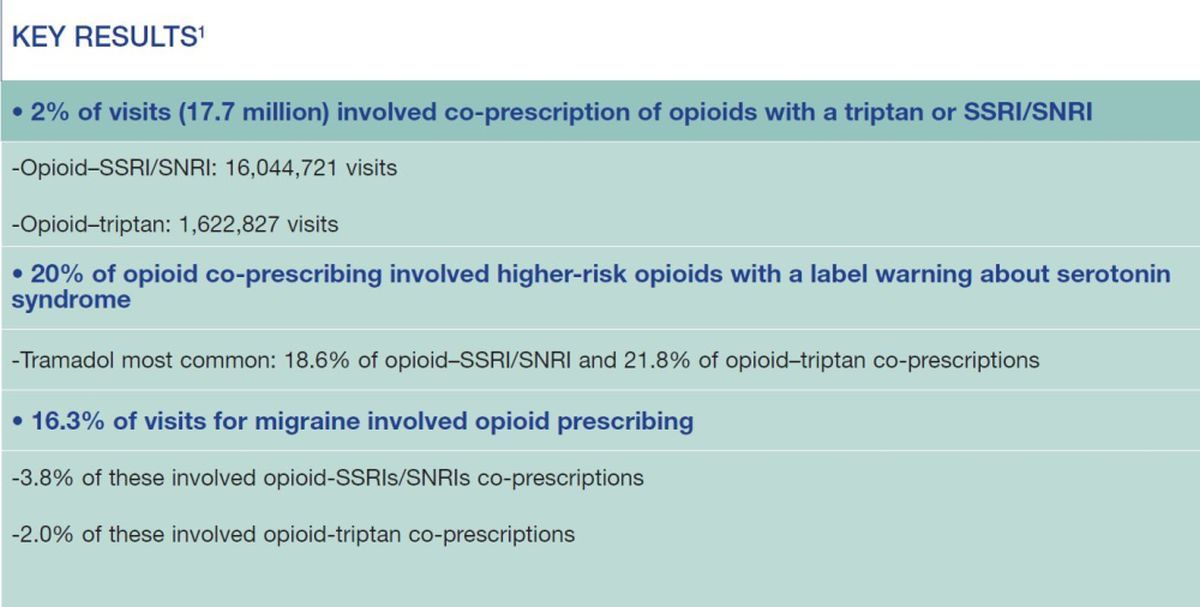Article
High Co-prescription of Opioid-SSRI/SNRIs, Despite the Risks
Author(s):
The combined use of opioids for migraine and triptans or SSRIs/SNRIs for depression can result in serotonin syndrome, which produces symptoms that range from mild to severe to potentially life-threatening.
©Lightspring/Shutterstock

Key results

RESEARCH UPDATE
Co-prescription of opioids and selective serotonin reuptake inhibitors (SSRIs) or serotonin and norepinephrine reuptake inhibitors (SNRIs) was common in the US from 2013 to 2014, according to a recent study.1 In March 2016 the FDA issued a safety warning about the risk of serotonin syndrome with combined use of opioids and triptans, or SSRIs/SNRIs.2 Whether the FDA warning has resulted in changes in prescribing practices is unknown, though it may be too early to know.
However, what’s clear is that the opioid problem in the US is not going away quickly. Despite recommendations against opioids for acute migraine from the American Academy of Family Physicians (AAFP) and the American Headache Society (AHS) and despite CDC guidelines3 against opioids for chronic non-cancer pain, prescription of opioids in the US tripled between 1999 and 2015.
Serotonin syndrome is a very rare but serious adverse effect of serotonergic antidepressants, caused by excess serotonergic agonism. Symptoms range from mild (diarrhea, shivering) to severe and potentially life-threatening (muscle rigidity, fever, seizures). The opioids most commonly linked to serotonin syndrome include fentanyl, methadone, andoxycodone. Meperidine, methadone and tramadol carry label warnings about the risk of serotonin syndrome.
To provide better epidemiological data about the nationwide prevalence of co-prescription of these medications in the period before the FDA warning, researchers lead by David A. Sclar, PhD, of the Midwestern University College of Pharmacy in Glendale, Arizona, used data from the National Ambulatory Medical Care Survey (NAMCS) database for 2013 to 2014. NAMCS is a cross-sectional nationally representative survey of office-based physician visits run annually by the National Center for Health Statistics (NCHS). The analysis included data from 903.6 million outpatient visits.
Key results and take home points >
Key results
• 2% of visits (17.7 million) involved co-prescription of opioids with a triptan or SSRI/SNRI
-Opioid–SSRI/SNRI: 16,044,721 visits
-Opioid–triptan: 1,622,827 visits
• 20% of opioid co-prescribing involved higher-risk opioids with a label warning about serotonin syndrome
-Tramadol most common: 18.6% of opioid–SSRI/SNRI and 21.8% of opioid–triptan co-prescriptions
• 16.3% of visits for migraine involved opioid prescribing
-3.8% of these involved opioid-SSRIs/SNRIs co-prescriptions
-2.0% of these involved opioid-triptan co-prescriptions
The authors emphasized that the prevalence of opioid prescriptions for migraine has changed little over the past decade. A complicating factor is that patients with migraine commonly suffer from depression, making them at increased risk of co-prescription for serotonergic antidepressants and opioids. While acknowledging the importance of effective pain control in migraine, they warned that these results should not discourage undertreatment of depression.
“[T]reatment with serotonergic antidepressants in patients with migraine and comorbid depression must not be unnecessarily discouraged, given the importance of treatment with appropriate pharmacotherapy and evidence that depression is highly prevalent and may be undertreated in this patient population,” they wrote.
They noted that the study precedes the FDA warning by about 2 years, and most of the study occurred before the 2014 DEA re-classification of tramadol as a schedule-IV controlled substance and hydrocodone as a schedule-II controlled substance. Further study is needed to evaluate how these changes may have affected prescribing practices.
Take home points
• Between 2013 to 2014, 2% of outpatient visits surveyed by NAMCS involved co-prescription of opioids with a triptan or SSRI/SNRI
• 20% of these involved higher-risk opioids with a label warning about serotonin syndrome
• 16.3% of visits for migraine involved opioid prescribing
• Further study is needed to evaluate how a 2016 FDA warning about co-prescription of opioids and SSRIs/SNRIS or triptans may have affected prescribing practices
References:
1. Molina KC, Fairman KA, Sclar DA, et al. Concomitant use of opioid medications with triptans or serotonergic antidepressants in US office-based physician visits. Drug Healthc Patient Saf. 2018 May 3;10:37-43. doi: 10.2147/DHPS.S151073.
2. US Food and Drug Administration. FDA Drug Safety Communication: FDA warns about several safety issues with opioid pain medicines; requires label changes. March 22, 2016. https://www.fda.gov/downloads/Drugs/DrugSafety/UCM491302.pdf. Accessed June 27, 2018.
3. Centers for Disease Control. Opioid prescribing is still high and varies widely throughout the U.S. https://www.cdc.gov/media/releases/2017/p0706-opioid.html. Accessed June 27, 2018.




